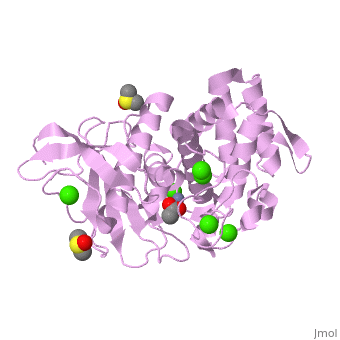2a7g
From Proteopedia
(Difference between revisions)
| Line 1: | Line 1: | ||
| - | + | ==On the Routine Use of Soft X-Rays in Macromolecular Crystallography, Part III- The Optimal Data Collection Wavelength== | |
| - | + | <StructureSection load='2a7g' size='340' side='right' caption='[[2a7g]], [[Resolution|resolution]] 1.85Å' scene=''> | |
| - | + | == Structural highlights == | |
| + | <table><tr><td colspan='2'>[[2a7g]] is a 1 chain structure with sequence from [http://en.wikipedia.org/wiki/Bacillus_thermoproteolyticus Bacillus thermoproteolyticus]. Full crystallographic information is available from [http://oca.weizmann.ac.il/oca-bin/ocashort?id=2A7G OCA]. For a <b>guided tour on the structure components</b> use [http://oca.weizmann.ac.il/oca-docs/fgij/fg.htm?mol=2A7G FirstGlance]. <br> | ||
| + | </td></tr><tr><td class="sblockLbl"><b>[[Ligand|Ligands:]]</b></td><td class="sblockDat"><scene name='pdbligand=ACY:ACETIC+ACID'>ACY</scene>, <scene name='pdbligand=CA:CALCIUM+ION'>CA</scene>, <scene name='pdbligand=DMS:DIMETHYL+SULFOXIDE'>DMS</scene>, <scene name='pdbligand=ZN:ZINC+ION'>ZN</scene><br> | ||
| + | <tr><td class="sblockLbl"><b>Activity:</b></td><td class="sblockDat"><span class='plainlinks'>[http://en.wikipedia.org/wiki/Transaldolase Transaldolase], with EC number [http://www.brenda-enzymes.info/php/result_flat.php4?ecno=2.2.1.2 2.2.1.2] </span></td></tr> | ||
| + | <tr><td class="sblockLbl"><b>Resources:</b></td><td class="sblockDat"><span class='plainlinks'>[http://oca.weizmann.ac.il/oca-docs/fgij/fg.htm?mol=2a7g FirstGlance], [http://oca.weizmann.ac.il/oca-bin/ocaids?id=2a7g OCA], [http://www.rcsb.org/pdb/explore.do?structureId=2a7g RCSB], [http://www.ebi.ac.uk/pdbsum/2a7g PDBsum]</span></td></tr> | ||
| + | <table> | ||
| + | == Evolutionary Conservation == | ||
| + | [[Image:Consurf_key_small.gif|200px|right]] | ||
| + | Check<jmol> | ||
| + | <jmolCheckbox> | ||
| + | <scriptWhenChecked>select protein; define ~consurf_to_do selected; consurf_initial_scene = true; script "/wiki/ConSurf/a7/2a7g_consurf.spt"</scriptWhenChecked> | ||
| + | <scriptWhenUnchecked>script /wiki/extensions/Proteopedia/spt/initialview01.spt</scriptWhenUnchecked> | ||
| + | <text>to colour the structure by Evolutionary Conservation</text> | ||
| + | </jmolCheckbox> | ||
| + | </jmol>, as determined by [http://consurfdb.tau.ac.il/ ConSurfDB]. You may read the [[Conservation%2C_Evolutionary|explanation]] of the method and the full data available from [http://bental.tau.ac.il/new_ConSurfDB/chain_selection.php?pdb_ID=2ata ConSurf]. | ||
| + | <div style="clear:both"></div> | ||
| + | <div style="background-color:#fffaf0;"> | ||
| + | == Publication Abstract from PubMed == | ||
| + | Complete and highly redundant data sets were collected at different wavelengths between 0.80 and 2.65 A for a total of ten different protein and DNA model systems. The magnitude of the anomalous signal-to-noise ratio as assessed by the quotient R(anom)/R(r.i.m.) was found to be influenced by the data-collection wavelength and the nature of the anomalously scattering substructure. By utilizing simple empirical correlations, for instance between the estimated deltaF/F and the expected R(anom) or the data-collection wavelength and the expected R(r.i.m.), the wavelength at which the highest anomalous signal-to-noise ratio can be expected could be estimated even before the experiment. Almost independent of the nature of the anomalously scattering substructure and provided that no elemental X-ray absorption edge is nearby, this optimal wavelength is 2.1 A. | ||
| - | + | On the routine use of soft X-rays in macromolecular crystallography. Part III. The optimal data-collection wavelength.,Mueller-Dieckmann C, Panjikar S, Tucker PA, Weiss MS Acta Crystallogr D Biol Crystallogr. 2005 Sep;61(Pt 9):1263-72. Epub 2005, Aug 16. PMID:16131760<ref>PMID:16131760</ref> | |
| - | + | ||
| + | From MEDLINE®/PubMed®, a database of the U.S. National Library of Medicine.<br> | ||
| + | </div> | ||
==See Also== | ==See Also== | ||
*[[Metalloproteases|Metalloproteases]] | *[[Metalloproteases|Metalloproteases]] | ||
*[[Thermolysin|Thermolysin]] | *[[Thermolysin|Thermolysin]] | ||
| - | + | == References == | |
| - | == | + | <references/> |
| - | < | + | __TOC__ |
| + | </StructureSection> | ||
[[Category: Bacillus thermoproteolyticus]] | [[Category: Bacillus thermoproteolyticus]] | ||
[[Category: Transaldolase]] | [[Category: Transaldolase]] | ||
Revision as of 03:00, 30 September 2014
On the Routine Use of Soft X-Rays in Macromolecular Crystallography, Part III- The Optimal Data Collection Wavelength
| |||||||||||


